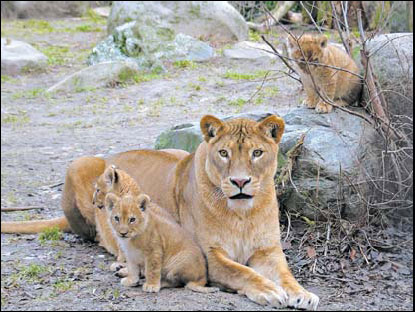Zoos ask: Now what?
 |
|
In Denmark, lions give birth and raise their cubs. Some are then culled at age 2. Copenhagen Zoo |
The thinking is that this strategy mimics what would have occurred in the wild, where some 80 percent of feline offspring die from predation, starvation or injury, he said.
Guidelines on the ethics of breeding zoo animals have been elusive, in part because philosophies vary, said Dave Morgan, chairman of the Population Management Committee at the World Association of Zoos and Aquariums.
The African association of zoos lists euthanasia as a population management tool, but the precepts of Hinduism and Buddhism make the killing of even terminally ill animals difficult.
Euthanasia is permitted under the American zoo association's regulations, but is mainly reserved for ill or elderly animals, said Steve Feldman, the association's spokesman.
Officials say that contraception is much more prevalent in North America but that it is starting to expand in Europe.
American zoos began developing contraception for highly fertile animals like lions in the 1970s, after breakthroughs in human birth control. Contraception use then expanded as it became quite difficult for zoos to sell or give away animals they could no longer accommodate.
This kind of family planning meant males and females no longer had to be kept apart to avoid unwanted pregnancies, which was ideal for the transition to more natural zoo environments.
There were benefits, too, for zookeepers: hormones in contraceptives given males can take the edge off aggressive behaviors surrounding competition for a mate, which can result in mayhem and unsettle visitors.
Genetic diversity is key to long-term species survival because it prevents inbreeding. It also preserves a broad array of traits that animals might one day need to survive in the wild.
Birth control is used for more than half of the female Western lowland gorillas held in 50 or so American zoos, said Kristen Lukas, who runs the species' breeding plan for the zoo association.
But contraceptive science for most exotic animals, Dr. Asa notes, is not as advanced as for apes, which are more closely linked to humans. And side effects can and do occur. Large cats and canines on early hormonal implants were susceptible to uterine infections and tumors. Other animals like elephants have trouble restarting their reproductive cycle once they come off birth control.
European zoos that prefer euthanasia cite health risks of contraception as well as the enrichment of parenting.
. But even when zoos wait to euthanize animals until their parents have had a chance to raise them, questions can come up. It might seem suspiciously convenient for zoos to destroy an animal just after it has completed its most adorable phase - given that baby animals are a top zoo attraction.
But Dr. Holst emphasized that the timing is dictated by nature. Zookeepers know it is time when young leopards start picking fights with their mother.
"It may be painful for us," he said, "but more natural to them."
The New York Times
















